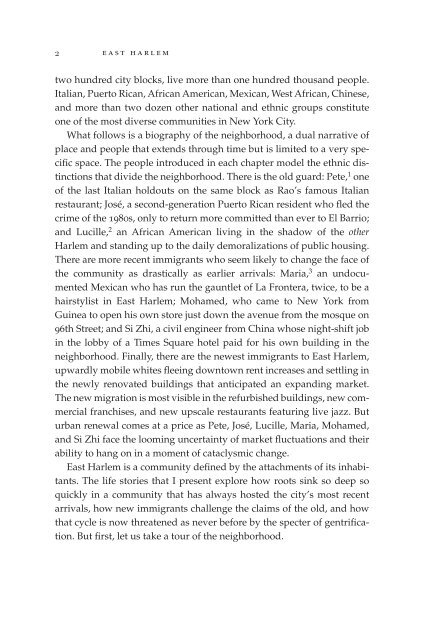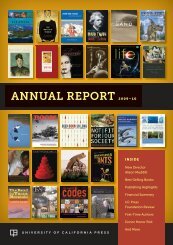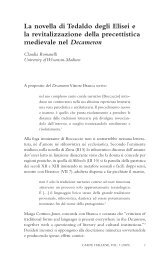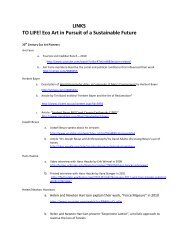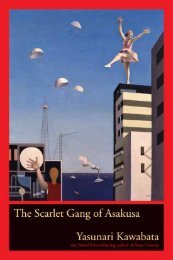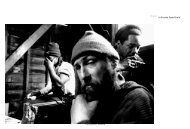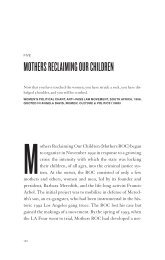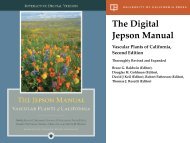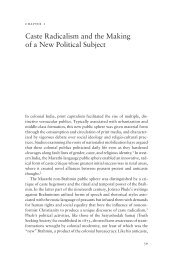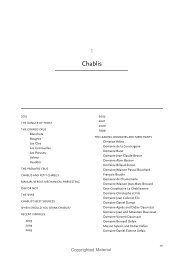Read Chapter 1 (PDF) - University of California Press
Read Chapter 1 (PDF) - University of California Press
Read Chapter 1 (PDF) - University of California Press
You also want an ePaper? Increase the reach of your titles
YUMPU automatically turns print PDFs into web optimized ePapers that Google loves.
2<br />
east harlem<br />
two hundred city blocks, live more than one hundred thousand people.<br />
Italian, Puerto Rican, African American, Mexican, West African, Chinese,<br />
and more than two dozen other national and ethnic groups constitute<br />
one <strong>of</strong> the most diverse communities in New York City.<br />
What follows is a biography <strong>of</strong> the neighborhood, a dual narrative <strong>of</strong><br />
place and people that extends through time but is limited to a very specific<br />
space. The people introduced in each chapter model the ethnic distinctions<br />
that divide the neighborhood. There is the old guard: Pete, 1 one<br />
<strong>of</strong> the last Italian holdouts on the same block as Rao’s famous Italian<br />
restaurant; José, a second-generation Puerto Rican resident who fled the<br />
crime <strong>of</strong> the 1980s, only to return more committed than ever to El Barrio;<br />
and Lucille, 2 an African American living in the shadow <strong>of</strong> the other<br />
Harlem and standing up to the daily demoralizations <strong>of</strong> public housing.<br />
There are more recent immigrants who seem likely to change the face <strong>of</strong><br />
the community as drastically as earlier arrivals: Maria, 3 an undocumented<br />
Mexican who has run the gauntlet <strong>of</strong> La Frontera, twice, to be a<br />
hairstylist in East Harlem; Mohamed, who came to New York from<br />
Guinea to open his own store just down the avenue from the mosque on<br />
96th Street; and Si Zhi, a civil engineer from China whose night-shift job<br />
in the lobby <strong>of</strong> a Times Square hotel paid for his own building in the<br />
neighborhood. Finally, there are the newest immigrants to East Harlem,<br />
upwardly mobile whites fleeing downtown rent increases and settling in<br />
the newly renovated buildings that anticipated an expanding market.<br />
The new migration is most visible in the refurbished buildings, new commercial<br />
franchises, and new upscale restaurants featuring live jazz. But<br />
urban renewal comes at a price as Pete, José, Lucille, Maria, Mohamed,<br />
and Si Zhi face the looming uncertainty <strong>of</strong> market fluctuations and their<br />
ability to hang on in a moment <strong>of</strong> cataclysmic change.<br />
East Harlem is a community defined by the attachments <strong>of</strong> its inhabitants.<br />
The life stories that I present explore how roots sink so deep so<br />
quickly in a community that has always hosted the city’s most recent<br />
arrivals, how new immigrants challenge the claims <strong>of</strong> the old, and how<br />
that cycle is now threatened as never before by the specter <strong>of</strong> gentrification.<br />
But first, let us take a tour <strong>of</strong> the neighborhood.


